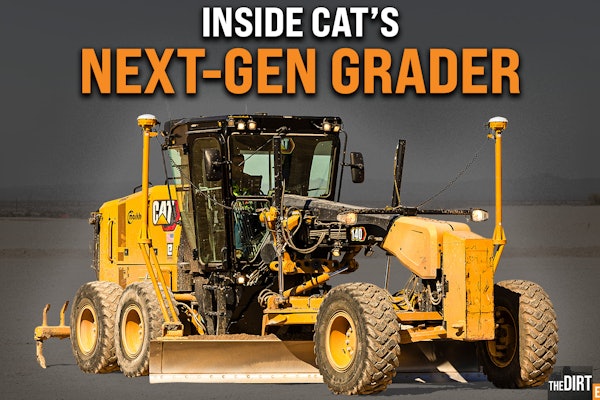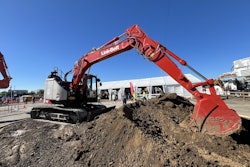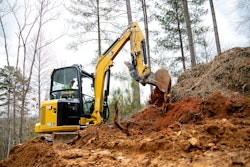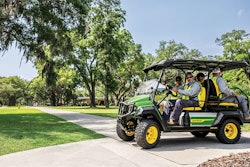Urban construction projects offer tight space challenges, especially when it comes to trenchers. While self-propelled trenchers are most effective for long runs, they typically can’t operate efficiently in compact surroundings. And in many cases, these large units may do more disruption to lawns and sensitive surfaces than a small-diameter utility line installation job warrants.
In these cases, your best bet is a smaller, walk-behind trencher. Horsepower ratings for these trenchers vary, but range from 5 to 18 gross horsepower, where ride-on units begin to take over.
While every utility installation job is different, taking into account the many variables that come into play on each job will dictate whether a walk-behind trencher or larger model is the best choice. Among these considerations are the size of the utility line to be installed, the length of the run, time constraints and the type of soil you’ll be working in.
Pedestrian trenchers in the less-than-18-gross-horsepower class top out with maximum cutting depths of 3 feet. Typical trench widths can be as narrow as 2 inches for smaller units and up to 6 inches across for the largest walk-behind machines. Anything larger and you’ll have to move to a higher horsepower pedestrian or self-propelled machine.
Distance figures for small trenchers aren’t as concrete, according to Brian Kenkel, product manager, Vermeer. Usually most pedestrian trenchers make 30-foot cutting runs at a time. “The installation job’s total distance might be 400 feet overall,” he notes. “Most operators will make short runs, stop and work, and then go back to trenching.”
Kenkel says in optimum soil conditions operators can expect to excavate 4 to 5 feet of trench per minute with small trenchers. “But if you need to make 400-foot runs nonstop, or if you’re only getting 2 feet a minute when trenching, you probably need to look at a larger machine to be productive,” he adds.
Trencher weight is also an important consideration. In extremely tough soil conditions, a combination of horsepower and machine weight can make a big difference in production. Additional machine weight holds the trenching boom in place (instead of allowing the unit to bounce around) and lets the chain bite into the soil more effectively.
Spec hydrostats for easier maintenance drivetrains
Efficient power transmission is key for productive trenching, regardless of machine size. In the past, almost all trencher drive systems were mechanical. “And that’s still an efficient way to transmit horsepower,” notes Brent Bolay, senior product manager, trenching products, Ditch Witch. “But over time we’ve seen advancements in hydraulics and the productivity they offer. As a result, many trenchers today, even walk-behind models, use some form of hydrostatic transmission to excavate earth.”
Bolay says hydrostatic drives come with a payoff. “They’re not quite as productive as mechanical drive systems,” he says. “But they’re much easier to maintain in terms of routine maintenance.”
“We used to have a belt-driven machine in this class,” Kenkel says. “You had to tension all those belts, and check periodically to make sure their adjustment was correct. If you didn’t, and something did break, it took a relatively long time to get it running again.” New hydrostat drives run independent wheel motors with hydraulic power. Kenkel says this system is more reliable because it doesn’t put as much stress on the machine if the operator goes over-relief.
Chain tension, configuration and speed are directly related to small trencher productivity.
Chain tension and configuration key to any successful trenching job
Grinding away at tough soil is never a good operational technique with trenchers, regardless of size. Selecting the proper chain and teeth to meet existing soil conditions can go a long way toward reducing unnecessary wear on the machine and enhancing its productivity.
Kenkel notes that if you rent walk-behind trenchers, you may not have much of a choice when it comes to tooth selection. “Rental outlets have a tendency to spec shark chains,” he explains. “That’s the toughest available, designed to cut through rocky, abrasive soils.”
It’s hard to fault the thinking. Shark chain can pretty much handle anything thrown its way – perfect for a machine with a high potential for abuse and misuse when it’s off the dealer lot.
But even though shark chain is tough, you’re wrong to think it will be the most productive choice in every application. In softer soils, you’ll actually move more earth if you spec cup teeth. As the name implies, these teeth actually scoop relatively large chunks of earth out of a trench, boosting production significantly. “If you own the trencher, it basically boils down to whether or not you’re willing to replace broken cups,” Kenkel says. “Cup cutters require more maintenance than shark chain. And it’s crucial that any worn or broken cups are replaced as soon as possible. One broken cup can aggravate wear on the entire chain if it’s not repaired.”
“Two things that wear chains the fastest are speed and tension,” Bolay notes. Speed isn’t a concern on smaller models because they only have one cutting speed. But chain tension has to be monitored regularly. “A chain that’s too tight engages the sprocket too tightly, which causes excessive wear on the rollers and pin,” Bolay says. “It also robs you of productive horsepower because the engine has to work that much harder just to rotate the chain around the boom.”
Running a chain too loose isn’t a good idea, either. “A chain with too much slack starts to curl at high cutting speeds,” Kenkel explains. Called back-flex, it allows the cutter to engage the ground and twist back into a knot, inflicting massive wear on the chain side bars and boom wear strip. The roller also catches on the sprocket teeth as it rotates. In worse case scenarios this can lead to broken rollers or pins.
An easy way to quickly check chain slack is by using what Kenkel calls his “two finger rule.” To do this, place your trencher’s boom horizontal to the ground. You’ll note the chain hangs loose off the bottom side of the boom. If the chain is tensioned properly, you should be able to easily slip two fingers between the chain and the bottom section of the boom. “If you can’t get two fingers in between the boom and chain, it’s too tight,” Kenkel says. “Any more than two fingers and you know it’s too loose.”
Another sure way to increase your small trencher productivity is to just take it easy, Bolay says. “These are small machines,” he notes. “They’re highly productive, and as long as you don’t overload them or push them too hard they’ll perform well in their niche.”









